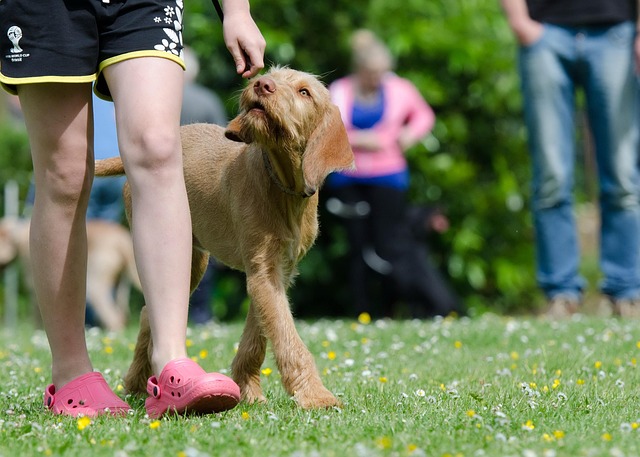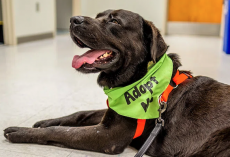New puppy or rescue at home? Teaching basic cues is one of the best ways to help your dog feel safe, confident and connected to you — and it’s an incredible bonding experience.
Here's a break down of which cues matter most and how to teach each one.
Before You Start: The Basics of Good Training
Effective training always comes back to positive reinforcement — rewarding behaviors you want so your dog repeats them.
Since every dog learns differently, you’ll discover through practice:
- Which treats motivate her most
- How long she can focus
- How quickly she picks up new skills
There is no one-size-fits-all way to teach every dog.
Start simple, train in quiet places, and always give clear, consistent feedback. Your dog will look to you for guidance — make sure the message is easy to understand.
What You Need
- Your dog
- Lots of treats (try these Crazy Dog Train-Me! dog treats from Amazon)
- A clicker (optional but helpful) – (like this two-pack from Amazon)
Use small training treats to avoid overfeeding during long practice days.
When to Train
Avoid practicing right after meals or when your dog is overly energetic.
Aim for a calm, focused state — even if it’s brief!
The 7 Basic Cues Every Dog Should Learn
1. Sit
One of the first cues most dogs learn — great for manners and impulse control.
- Hold a treat in your closed hand and place it in front of her nose.
- Move your hand slowly up and over her head.
- As she looks up, her bottom should naturally lower to the floor.
- Mark with “yes!” (or a click) and reward.
- When she’s consistent, repeat the motion with an empty hand and reward from your other hand.
This teaches her to offer the behavior without seeing the food first.
2. Stay
Helps keep your dog from bolting out doors or getting overly excited on walks.
- Ask for a “sit” or “down.”
- Show your dog your open palm (no verbal cue yet).
- Silently count “two Mississippi,” then mark and reward.
- After three good reps, try “four Mississippi.”
- If she breaks, say “eh-eh,” turn away briefly, and try again with a shorter count.
- When she can stay reliably for 20 seconds, add the verbal cue “stay.”
3. Come (Recall)
One of the most important safety cues you’ll teach.
- Say her name once, then reward her so she learns her name predicts something good.
- Mark and reward her anytime she comes to you on her own.
- Add distance: call once (while she’s not distracted), reward when she reaches you.
- Gradually practice from farther away.
Keep it fun — “come” should always feel like the best choice in the world.
4. Heel
Keeps your dog walking calmly and focused beside you.
- Call your dog using the “come” cue.
- When she arrives, lure her nose to your side with a treat, mark and reward.
- Release her forward, then cue again and reward when she joins you.
- Slowly increase the number of steps she walks at your side before marking.
5. Down
A great cue for calmness and manners.
- Kneel in front of your dog.
- Hold a treat tightly in your fist with one finger pointed out.
- Move your hand from her chest down to the floor, then toward your body.
- Reward only when she is fully lying down.
- If she struggles, reward small progress (bent elbows, moving downward).
- Once consistent, use an empty hand and reward from your pocket.
- Gradually stand upright while giving the signal.
- Add the verbal cue “down” once she performs it 90% of the time.
6. Leave It
Essential for avoiding dangerous objects or tempting snacks.
- Hold a treat in your closed fist.
- If she licks or paws, move your hand away.
- If she backs off, mark and reward with a treat from the other hand.
- Add the words “leave it” as she withdraws.
- Progress by placing a treat on the floor (ready to cover it with your foot).
- Increase difficulty with higher-value items.
7. Place
Teaches your dog to go to a designated spot — perfect for calming excitement.
- Put down a bed or mat and drop a treat as it lands.
- Lure her onto the mat saying “go to place.” Reward.
- Release her with a cue like “OK.”
- Repeat until she starts running to the mat herself.
- Practice sending her from farther distances.
Bonus: Teach Your Dog “Paw”
- Ask your dog to sit.
- Gently tap behind her front knee until she lifts her paw. Mark and treat.
- Next time, slip your hand under her paw as she lifts it.
- Repeat 5–10 times.
- Try holding your hand out without tapping.
- Once consistent, add the verbal cue (“paw” or “high five”).
- Slowly reduce the number of treats.
Extra Training Tips
Give your dog exercise first
A tired mind and body learns better. Walks, play, puzzle toys — all help.
Train when your dog is calm and hungry
You can even use her kibble as training rewards.
Keep sessions short
2–5 minutes each, several times a day.
Make training fun
If either of you get frustrated, take a break and try again later.
Keep treats handy
Store treat containers in different rooms so you can reward good behavior anytime.
Use different value treats
To teach your dog that anytime is a potential opportunity to earn something (so she’s always on her best behavior), place containers of treats in different areas around the home or carry a pouch with three types of treats that vary in value:
- Low-value: kibble or cookie-type treats
- Medium-value: pea-sized soft-chew training treats, like Zukes, Wellness Soft Treats or True Chews Jerky Cuts
- High-value: chicken, hot dogs, cheese, or dehydrated treats, like Stella & Chewy's
Use higher-value rewards for harder or newer cues.
Teach the hand signal first
Dogs learn visually before they learn verbally.
Say verbal cues once
Repeating cues teaches your dog that words don’t matter — so say it once, then wait.
Practice everywhere
Living room → hallway → backyard → sidewalk.
New spaces help make cues rock solid.
Gradually reduce treats
Switch to varied schedules and use other rewards like toys, praise or going outside.
With these seven cues down, you and your dog will be ready to tackle more advanced tricks — yes, even fetching a drink from the fridge someday!
Just remember to be patient, always use only positive reinforcement and give your pup plenty of breaks if you start to notice her getting restless.
We independently pick all the products we recommend because we love them and think you will too. If you buy a product from a link on our site, we may earn a commission.











